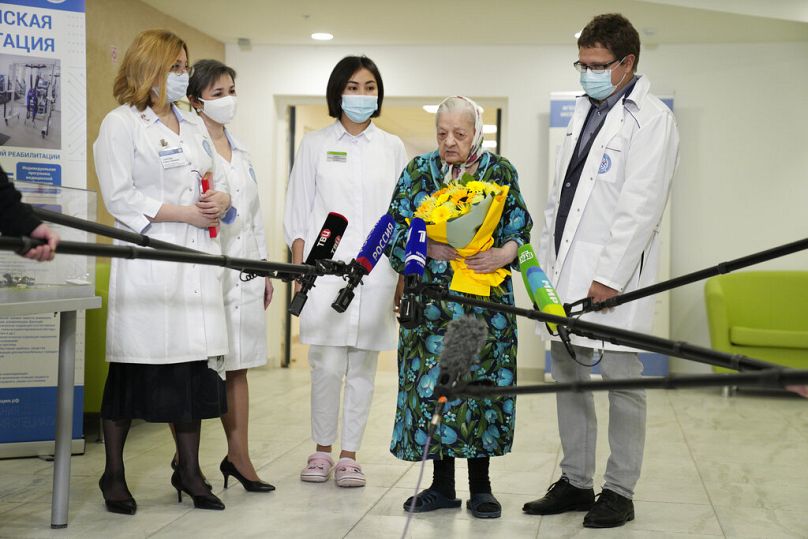Medical professionals say that more data on who is dying and whether they were vaccinated would help fight anti-vax sentiment.
Public health professionals and journalists in Hungary and other countries in central and Eastern Europe have demanded greater transparency and more detailed data on the COVID-19 pandemic since some of the first outbreaks last year.
But in many cases, information is still hard to come by, even though some experts say that greater government transparency could help boost lagging vaccination rates and mitigate a new surge in cases and deaths in the region.
Dr Zoltan Komaromi, a family doctor in Budapest told the Associated Press that the Hungarian government should "disclose data for each case of illness, what vaccine the patient received, when it was administered and the severity of each illness in relation to the vaccination."
In Hungary, a country of fewer than 10 million inhabitants, COVID-19 infection rates in recent weeks have broken records while daily deaths per capita are the highest in the world.
But despite this, vaccine hesitancy has remained a stubborn problem due to lack of official communication on the pandemic.
While Hungary was an early vaccination leader in Europe due to its procurement of jabs from China and Russia as well as through the European Union, vaccination rates in recent months have dropped dramatically.
Nearly 30% of the adult population in Hungary has still not received a single dose.
That, coupled with loose mitigation measures has given Hungary a seven-day average of nearly 200 daily deaths, part of a surge that has still not provoked vaccine sceptics to get a jab.
Governments in many countries - like the United States, the United Kingdom and Germany - publish detailed online dashboards where users can learn about pandemic trends through interactive maps, graphs and other data.
But Hungary's coronavirus website features no geographic breakdowns of pandemic trends, and updates to pandemic numbers are published each day in a block of text which contains no data visualizations that show the relative rise or decline in pandemic indicators.
Illes Szurovecz, a Journalist with Hungarian news website 444.hu, says the data the government releases is insufficient for getting a clear picture of how the pandemic is developing, and that the information that is provided is opaque and difficult to follow.
The Hungarian government publishes only very basic data each day on the number of infections and deaths, how many are in hospitals and how many received a vaccine. But Szurovecz said that's not enough.
Among the data requested by experts and journalists are regional and municipal breakdowns of infections, deaths and vaccination rates.
Hungary's government and the National Public Health Center did not respond to requests for comment.
Last month, Hungary's National Authority for Data Protection and Freedom of Information released a statement requesting that the government release infection data at the municipal level to mayors.
The statement read that both local leaders and the public "need to know the figures in order to make informed decisions about how to protect themselves against the pandemic."
Similar problems were reported earlier during the pandemic in the Czech Republic, where local mayors said they lacked details about the numbers of infected people in their towns and cities.
This harmed some of their mitigation efforts, such as distributing personal protective equipment, but issues were ultimately remedied late last year.
Trust in official statistics has also been a problem in Russia, where some experts have criticized official data on COVID-19 infections and deaths provided by Russia's state coronavirus task force.
They argued that the reported numbers were likely an undercount.
Data analysts have pointed to inconsistencies in Russia's virus statistics that they say suggest manipulation.
Their research pointed at regions reporting similar numbers of new cases for days in a row, or the number of deaths in regional reports differing from those in federal reports.
As of Thursday, Russia's task force has reported over 9.8 million confirmed cases of the virus throughout the pandemic and 282,462 deaths – the highest death toll in Europe so far.
But a report released last week by the state statistics agency Rosstat, which uses broader criteria, put the overall number of virus-linked deaths between April 2020 and October 2021 to over 537,000.
This was almost twice the official toll, even though the number doesn't include the count for November and the first week of December.
In Hungary, experts and journalists have often taken matters into their own hands in an effort to procure more detailed information, despite efforts by the government to withhold data.
Lacking detailed official data, many of Hungary's journalists have tried to report from inside hospitals to get a clearer picture of conditions on the ground.
But Hungary's government has barred journalists from entering medical facilities to report on the pandemic, and prohibited medical staff from giving interviews.
According to Szurovecz, "the press is not allowed to report from hospitals at any level".
He believes that if media was allowed into hospitals and doctor's show the "stresses and strains of their job" people would "be more careful".
During a devastating surge in the pandemic last March, more than two dozen Hungarian media outlets sent an open letter to the government demanding greater transparency.
The letter stated that lack of access to hospitals made it impossible to report on worsening conditions there, creating a false picture of the situation's severity.
Hungary's government has argued that testing is an ineffective means of controlling the pandemic, and that only mass vaccination can save lives.
It also contends that the country's high official death rate is the result of broader criteria for attributing a death to COVID-19.
During comments in Hungary's parliament this week, an opposition lawmaker asked Prime Minister Viktor Orban why the COVID-19 death rate in Hungary was so much higher than some of its neighbours.
Orban denied the higher death rates in the country, compared with anywhere else and said that this was an insult to Hungarian doctors' efforts.












